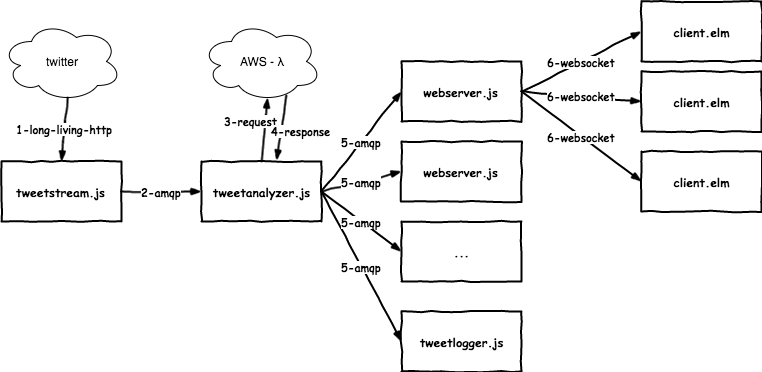Twitter Sentiment Analysis(TSA) is a cloud software platform for massive tweet analysis. TSA allows the user to run real-time sentiment analysis on one or multiple twitter streams. A web client then will visualize the analysis results in real time. TSA also gives the user the possibility to record the stream for a specified time.
In order to handle a any amount of tweets and clients concurrently TSA needs to be highly scalable and is therefore a perfect fit for "The Cloud".
Twitter is a social network for sharing messages (called tweets) all over the world. A tweet is a short text message of at most 140 characters. About 7500 tweets are created each second from users all over the world. See http://www.internetlivestats.com/twitter-statistics/ for more information.
A Web-UI allows the user to specify which Twitter streams he or she wants to have analyzed. To allow the user to see the sentiment analysis in real time, the web browser is connected to one of several web servers (EC2 t2.nano), which will reside behind a load balancer. Since the Twitter API does only permit one simultaneous connection, a single web server, dedicated to receiving the incoming messages from Twitter, will be deployed separately. The CPU intensive tasks, i.e. the sentiment analysis will be done by AWS Lambda. As soon as AWS Lambda is finished analyzing the Tweets, the resulting sentiment data is routed through the correct web server and web socket to the user. There the result will be visualized in the Web-UI.
If the user wants to have a look at the sentiment data at later point in time, the result of the analysis needs to be persisted. This is done using an AWS DynamoDB instance that can be directly accessed by AWS Lambda and AWS EC2. By accessing the DynamoDB directly from Lambda the workload of the EC2 can be reduced.
The following technologies will be used with the different cloud services:
- Web Server: The web server running on the AWS EC2 instance will be build using node.js.
- Sentiment Analysis: The sentiment analysis running on AWS lambda will be implemented with node.js.
- Persistence: DynamoDB, the NoSQL DB by AWS will be used to have greater flexibility and better scalability compared to a SQL database
The following diagram shows the involved components
To be able to determine if the application is developed properly for the cloud, a load test will be done. During the load test multiple AWS EC2 instances will be used, to simulate several hundred users. If the cloud application is setup correctly additional EC2 instances will be started automatically when the load gets too high. Similarly a single running instance could be terminated, which should be compensated for without any manual work.
The sentiment data generated by the backend will be visualized in a graph chart in real-time. Each Twitter Stream that the user subscribes to will be represented by a graph. The time is displayed on the x-axis and the sentiment on the y-axis.
After the core functionality described above is fully implemented, the following additional tasks could be worked on.
The sentiment analysis could be ported to an AWS EC2 instance. This would allow a comparison of scalability and cost of Lambda and EC2 when doing CPU heavy tasks.
The application could be extended with additional cloud services. One possibility would be to use AWS SES (Simple Email Service) to allow users to trigger the sentiment analysis of Twitter streams via email and/or receive the result via email.

